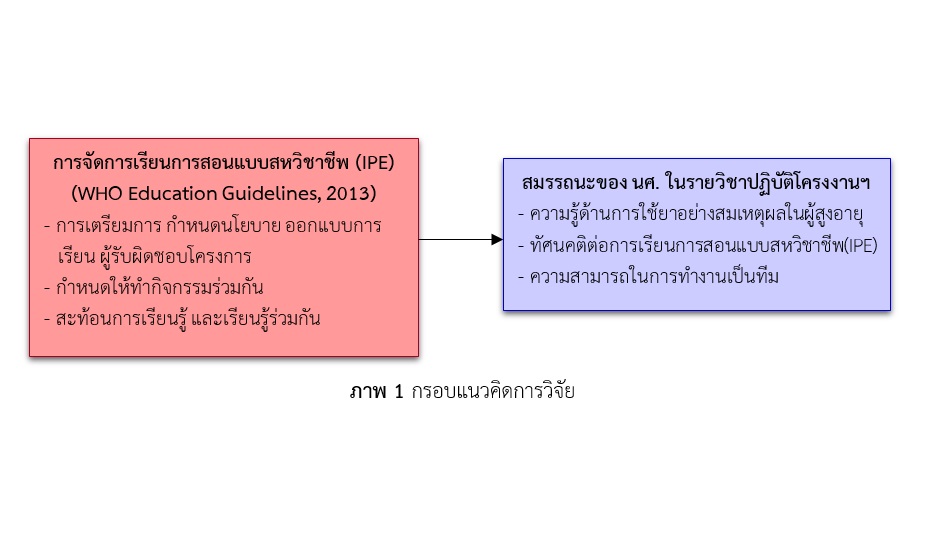ผลของการเรียนแบบสหวิชาชีพต่อความรู้ในการใช้ยาอย่างสมเหตุผลในผู้สูงอายุ ทัศนคติ และความสามารถในการทำงานเป็นทีมของนักศึกษาพยาบาลศาสตร์ ในรายวิชาปฏิบัติโครงงานพัฒนาสุขภาพ
คำสำคัญ:
การเรียนการสอนแบบสหวิชาชีพ, ความรู้ในการใช้ยาอย่างสมเหตุผลในผู้สูงอายุ, ทัศนคติความสามารถในการทำงานเป็นทีมบทคัดย่อ
งานวิจัยกึ่งทดลองแบบกลุ่มเดียววัดก่อนและหลังนี้ มีวัตถุประสงค์เพื่อศึกษาความรู้ในการใช้ยาอย่างสมเหตุผลในผู้สูงอายุ ทัศนคติ ความสามารถในการทำงานเป็นทีมของนักศึกษาพยาบาลศาสตร์ต่อการเรียนแบบสหวิชาชีพ และเปรียบเทียบความรู้ในการใช้ยาอย่างสมเหตุผลในผู้สูงอายุต่อทัศนคติ และความสามารถในการทำงานเป็นทีม ภายหลังการเรียนแบบสหวิชาชีพ ในกลุ่มตัวอย่างนักศึกษาพยาบาลศาสตรบัณฑิต ชั้นปีที่ 4 จำนวน 61 คน เครื่องมือในการศึกษาวิจัยมี 1) แบบประเมินความรู้ของนักศึกษาในการใช้ยาสมเหตุผลในวัยผู้สูงอายุ 2) แบบประเมินทัศนคติของนักศึกษาต่อ การเรียนแบบสหวิชาชีพ และ 3) แบบประเมินทักษะการทำงานเป็นทีม มีค่าความเชื่อมั่นเท่ากับ .74, .81 และ .91 ตามลำดับ กำหนดการให้นักศึกษาได้สร้างสัมพันธภาพและทำงานร่วมกัน 5 ครั้ง ครั้งละ 3-4 ชม. การวิเคราะห์ข้อมูลใช้ค่าเฉลี่ย ส่วนเบี่ยงเบนมาตรฐาน และสถิติ Dependent Pair t-test ผลการวิจัยพบว่า
1. ระดับความรู้ในการใช้ยาอย่างสมเหตุสมผลในผู้สูงอายุของนักศึกษาพยาบาลศาสตร์ต่อการเรียนแบบสหวิชาชีพ ก่อนการเรียนอยู่ระดับปรับปรุง (M=13.30, SD=1.10) ภายหลังการเรียนนักศึกษามีระดับความรู้ที่อยู่ในระดับดีที่สุด (M=21.98, SD=1.39)
2. ทัศนคติ และความสามารถในการทำงานเป็นทีมของนักศึกษาพยาบาลศาสตร์ต่อการเรียนแบบสหวิชาชีพ ก่อนการเรียนอยู่ระดับปานกลาง (M=2.72, SD=0.13, M=3.18, SD=0.53) ภายหลังการเรียนอยู่ในมีระดับมากที่สุด และมากตามลำดับ (M=4.62, SD=0.49, M=4.16, SD=0.49)
3. การเปรียบเทียบความแตกต่างระหว่างความรู้ในการใช้ยาอย่างสมเหตุสมผลในผู้สูงอายุ ทัศนคติ และความสามารถในการทำงานเป็นทีม ภายหลังการเรียนแบบสหวิชาชีพ (Inter-Professional Education: IPE) มีความแตกต่างกันอย่างชัดเจน โดยมีค่าระดับคะแนนภายหลังการเรียนแบบสหวิชาชีพดีกว่าก่อนเรียนทุกด้าน อย่างมีนัยสำคัญทางสถิติที่ p<.001
การเรียนแบบสหวิชาชีพนักศึกษาต้องมีความรู้ในศาสตร์ของตนเอง และควรศึกษาความรู้ของสหวิชาชีพอื่นด้วย เพื่อให้การเรียนรู้ที่ลึกซึ้งมากยิ่งขึ้น ซึ่งจะมีความมั่นใจในการแบ่งปันความรู้ให้กับวิชาชีพอื่นได้ และการจัดการเรียนแบบสหวิชาชีพ
เอกสารอ้างอิง
Boonchom, S. (2013). Introduction to Research. (9th ed). Bangkok: Suweeriyasarn. (in Thai)
Brandt, B., Lutfiyya N. M., King, J., & Chioreso, C. (2014). A Scoping Review of Interprofessional Collaborative Practice and Education Using the Lens of the Triple Aim. Journal of Interprofessional Care, 28(5), 393-399.
Brashers, V., Erickson, J. M., Blackhall, L., Owen, J. A., Thomas, S. M., & Conaway, M. R., (2016). Measuring the Impact of Clinically Relevant Interprofessional Education on Undergraduate Medical and Nursing Student Competencies: A Longitudinal Mixed Methods Approach. Journal of Interprofessional Care, 30(4), 448-457.
Chenkongkaew, W. (2018). Manual of Interprofessional Education. (2nd ed). Bangkok: P.A.Living. (in Thai)
Cohen, J. (1988). Statistical Power Analysis for the Behavioral Sciences. (2nd). New Jersey: Lawrence Erlbaum Associates, Publishers.
Colonio Salazar, F. B., Andiappan, M., Radford, D. R., & Gallagher, J. E. (2016). Attitudes of the first Cohort of Student Groups Trained Together at the University of Portsmouth Dental Academy Towards Dental Interprofessional Education. Retrieved in September 26, 2017 from https://onlinelibrary.wiley.com/doi/abs/10.1111/eje.12183
Commission on Interprofessional Education. (2015). Inter-Professional Education. Retrieved in September 26, 2017 from http://www.healthprofessionals21thailand.org/wp-content/uploads//11/Book-IPE-Fin.pdf
Faul, F., Erdfelder, E., Lang, A. G., & Buchner, A. (2007). G*Power 3: A Flexible Statistical Power Analysis Program for the Social, Behavioral, and Biomedical Sciences. Behavior Research Methods, 39(2), 175-191.
Poorananon, P., & Krirkgulthorn, T. (2011). Factors Predicting Nursing Student’s Competency in Evidence-Based Nursing. J Nurs Sci, 29(2), 47-55. (in Thai)
Rational Use of Drug Subcommittee. (2017). Teacher’s Guide for Promoting Rational Drug Use. Bangkok: Agricultural Cooperative Printing Demonstrations of Thai Ltd. (in Thai)
Rotz, E. M., Duenas, G. G., Grove, A. B., Headly, A., & Parvanta, C. F. (2015). Exploring First-Year Pharmacy and Medical Students’ Experiences During a Longitudinal Interprofessional Education Program. Pharm Teach Lear, 7(3), 302–311.
Rungruang, K., Plosingehan, S., & Phuvipadawit, S. (2013). Factors Affecting The Nursing Professional In tention of Nursing Students in Colleage of Nursing Under The Ministry of Public Health. Journal of Nursing and Education, 6(3), 119-127. (in Thai)
Sethasathien, S. (2015). A Model of Interprofessional Education (IPE) in Department of Physical Medicine and Rehabilitation, Udonthani Hospital. J Thai Rehabil Med, 25(2), 65-70. (in Thai)
Stull, C. L., & Blue, C. M. (2016). Examining the Influence of Professional Identity Formation on the Attitudes of Students Towards Inter-Professional Collaboration. Journal of Inter-Professional Care, 30(1), 90-96.
Tanglakmankhong, K., Khammathit, A., Thammawongsa, N., & Ardpara, A. (2019). The Effectiveness of Teaching in a Nursing Innovation Course Using Interprofessional Education (IPE) Approach on Readiness for IPE, and the 21st Century Skills. The Southern College Network Journal of Nursing and Public Health, 6(2), 126-139.
World Health Organization. (2013). Interprofessional Education Guildline. Retrieved from http://www. WHO/HRH /HPN /10.3.
World Health Organization. (2010). Framwork for Action on Interprofessional Education & Collaborative Practice. Retried from http://www. WHO/HRH /HPN /10.3.
World Health Organization. (2002). Promoting Rational Use of Medicines: Core Components. WHO Policy Perspectives on Medicines. No.5. Document WHO/EDM/2002.3. Geneva, 2002. Retried from URL:http://apps.who.int/medicinedocs/pdf/h3011e/h3011e.pdf
Zeeni, N., Zeenny, R., Hasbini-Danawi, T., Asmar, N., Bassil, M., Nasser, S. et al. (2016). Student Perceptions Towards Interprofessional Education: Findings from a Longitudinal Study Based in a Middle Eastern University. Journal of Interprofessional Care, 30(2), 165-174. doi:10.3109/13561820.2015.1117060

ดาวน์โหลด
เผยแพร่แล้ว
ฉบับ
ประเภทบทความ
สัญญาอนุญาต
1. บทความหรือข้อคิดเห็นใด ๆ ที่ปรากฏในวารสารเครือข่าย วิทยาลัยพยาบาลและการสาธารณสุขภาคใต้ ที่เป็นวรรณกรรมของผู้เขียน บรรณาธิการหรือเครือข่ายวิทยาลัยพยาบาลและวิทยาลัยการสาธารณสุขภาคใต้ ไม่จำเป็นต้องเห็นด้วย
2. บทความที่ได้รับการตีพิมพ์ถือเป็นลิขสิทธิ์ของ วารสารเครือข่ายวิทยาลัยพยาบาลและการสาธารณสุขภาคใต้







